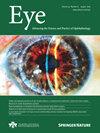Anatomical and functional results of patients with late-stage age-related macular degeneration 6 months after smaller-incision new-generation implantable miniature telescope (SING IMT™) implantation
IF 2.8
3区 医学
Q1 OPHTHALMOLOGY
引用次数: 0
Abstract
The aim of the study was to evaluate anatomical and functional outcomes of the Smaller-Incision New Generation Implantable Miniature Telescope (SING IMT™) in patients with bilateral advanced age-related macular degeneration (AMD). This non-comparative retrospective single-surgeon interventional case series included patients with bilateral late-stage AMD who underwent cataract surgery and SING IMT™ implantation at the Sant’Anna University Hospital, University of Ferrara, Italy. The main outcome measures included corrected distance (CDVA) and near visual acuity (CNVA), endothelial cell loss (ECL), and incidence of complications. 11 eyes of 11 patients were included. The mean follow-up duration was 6.5 ± 2.4 months. After surgery, CDVA significantly improved (from 17.00 ± 9.74 to 26.00 ± 8.53) letters (P = 0.008). Significant improvement of CNVA was also observed (from 12.27 ± 4.36 to 8 ± 2.61 Jaeger levels; P = 0.004). Mean ECL was 4.8 ± 5.5% at 3 months. No intraoperative complications were observed, while postoperative complications included iris incarceration (9.1%), pigment deposition on the device (9.1%), and transient corneal oedema (27.3%). Nevertheless, 10 of 11 patients (90.9%) began to complain of blurred or hazy vision within 3 months of surgery. The device was ultimately explanted in 3 patients (27.3%) because of this symptom. Although SING IMT™ implantation is associated with promising objective results, unexplained blurred or hazy vision represents common postoperative complaints which may lead to patient dissatisfaction. Further studies including patient-reported outcomes are warranted to evaluate the effect of the intervention on patients’ visual function and quality of life.

小切口新一代植入式微型望远镜(SING IMT™)植入术6个月后晚期老年性黄斑变性患者的解剖和功能结果
目的:本研究的目的是评估小切口新一代植入式微型望远镜(SING IMT™)在双侧晚期老年性黄斑变性(AMD)患者中的解剖和功能结果。方法:该非比较回顾性单外科医生介入病例系列包括在意大利费拉拉大学Sant’anna大学医院接受白内障手术和SING IMT植入的双侧晚期AMD患者。主要结局指标包括矫正距离(CDVA)和近视力(CNVA)、内皮细胞损失(ECL)和并发症发生率。结果:纳入11例患者11只眼。平均随访时间为6.5±2.4个月。术后CDVA明显改善(由17.00±9.74个字母改善至26.00±8.53个字母)(P = 0.008)。CNVA也有显著改善(从12.27±4.36降至8±2.61耶格水平;p = 0.004)。3个月时平均ECL为4.8±5.5%。术中无并发症,术后并发症包括虹膜嵌顿(9.1%)、色素沉积(9.1%)、短暂性角膜水肿(27.3%)。然而,11例患者中有10例(90.9%)在手术后3个月内开始抱怨视力模糊或模糊。最终有3例(27.3%)患者因该症状而拔出该装置。结论:尽管SING IMT植入具有良好的客观结果,但不明原因的视力模糊或模糊是常见的术后主观性,可能导致患者不满意。进一步的研究包括患者报告的结果,以评估干预对患者视觉功能和生活质量的影响。
本文章由计算机程序翻译,如有差异,请以英文原文为准。
求助全文
约1分钟内获得全文
求助全文
来源期刊

Eye
医学-眼科学
CiteScore
6.40
自引率
5.10%
发文量
481
审稿时长
3-6 weeks
期刊介绍:
Eye seeks to provide the international practising ophthalmologist with high quality articles, of academic rigour, on the latest global clinical and laboratory based research. Its core aim is to advance the science and practice of ophthalmology with the latest clinical- and scientific-based research. Whilst principally aimed at the practising clinician, the journal contains material of interest to a wider readership including optometrists, orthoptists, other health care professionals and research workers in all aspects of the field of visual science worldwide. Eye is the official journal of The Royal College of Ophthalmologists.
Eye encourages the submission of original articles covering all aspects of ophthalmology including: external eye disease; oculo-plastic surgery; orbital and lacrimal disease; ocular surface and corneal disorders; paediatric ophthalmology and strabismus; glaucoma; medical and surgical retina; neuro-ophthalmology; cataract and refractive surgery; ocular oncology; ophthalmic pathology; ophthalmic genetics.
 求助内容:
求助内容: 应助结果提醒方式:
应助结果提醒方式:


